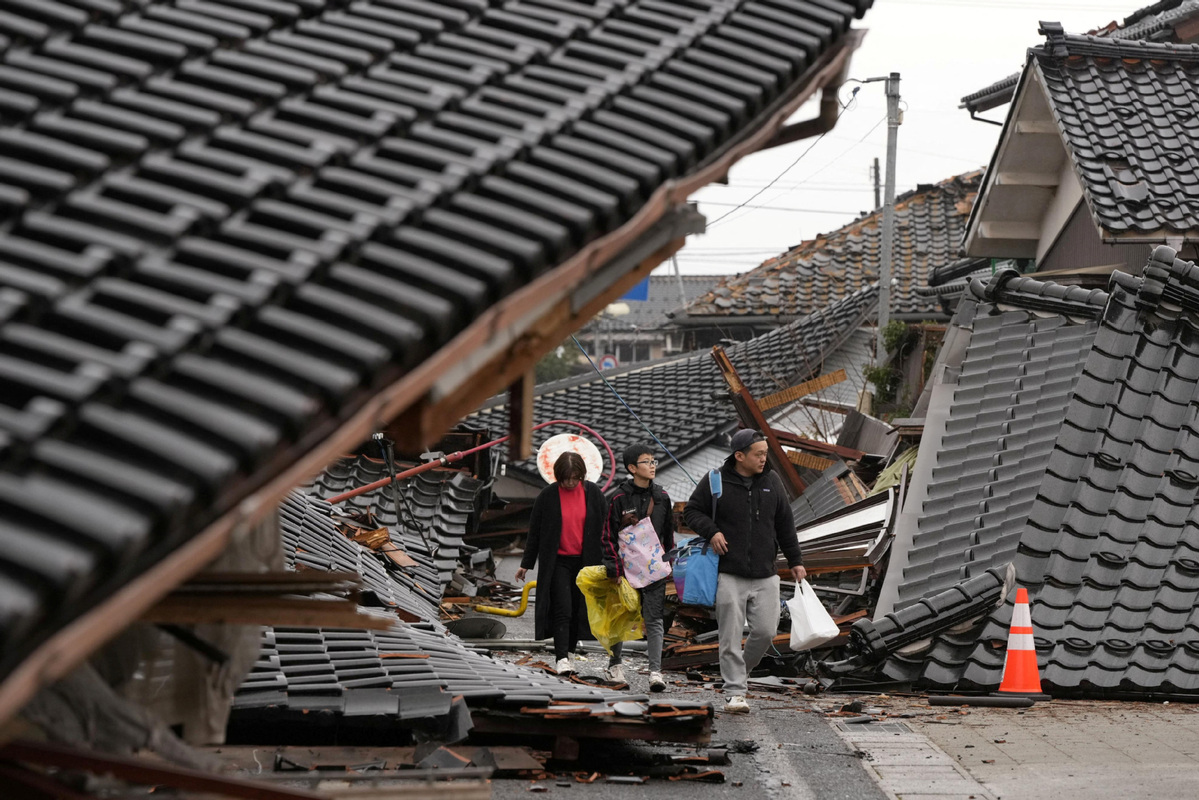Japanese PM pledges continued support as earthquake rescue operations continue
Xinhua | Updated: 2024-01-03 23:29

TOKYO -- The death toll has climbed to 73 in the central Japanese prefecture of Ishikawa on Wednesday, after a series of powerful earthquakes hit the area in central Japan and the vicinity, with the prime minister pledging continued support for people suffering from the disaster.
Of the deaths, 39 were reported in the worst-hit city of Waji
ma and 23 in Suzu, while the other deaths were counted in five neighboring towns, public broadcaster NHK said, citing local authorities, noting that people are missing in various parts of Ishikawa Prefecture and efforts are underway to confirm their safety.
Meanwhile, more than 300 people have been injured, at least 25 of them seriously, it added.
In a series of aftershocks experienced by the region, one of a magnitude of 5.6 on Wednesday morning and one of a magnitude of 4.6 on Tuesday evening struck off the Noto Peninsula, both at shallow depths and measuring upper 5 on Japan's seismic intensity scale which peaks at 7, according to the Japan Meteorological Agency (JMA).
Many collapsed houses have been confirmed in Wajima city, Suzu city, and Noto town of the prefecture, with the local government working to evaluate the damage situation, NHK said.
The full extent of the disaster remains unknown as rubble and severed roads have added to the challenges in search and rescue operations on Wednesday, two days after the 7.6-magnitude quake on New Year's Day rocked Ishikawa Prefecture and nearby areas and set off tsunami warnings.
The land ministry said areas of at least 100 hectares in Ishikawa Prefecture were flooded by tsunami waves following Monday's earthquake, while the true extent of the flooding will likely be larger.
The first 72 hours are especially critical for rescues because the prospects for survival greatly diminish after that, experts say.
"More than 40 hours have passed since the disaster. This is a race against time, and I feel that we are at a critical moment," Japanese Prime Minister Fumio Kishida told a press conference on Wednesday. "We have received reports many people are still waiting for rescue under collapsed buildings."
Japan's Self-Defense Forces (SDF) were set to use helicopters to deliver supplies to cut-off areas, with local authorities asking the central government to send SDF personnel for disaster relief mission.
Kishida said that the government had decided to double the number of SDF members to be mobilized in the disaster-hit region from 1,000 at present to 2,000, with more rescue dogs also deployed.
Kishida later said 2,000 firefighters and 740 police officers will newly join the search and rescue efforts, noting that transport of relief supplies is crucial as affected people may have to live in temporary shelters for a longer period of time.
In Ishikawa alone, about 33,000 people are staying at evacuation centers, and over 30,000 homes were without power. In Ishikawa and two neighboring prefectures of Toyama and Niigata, 110,000 homes were without water supply, Kyodo News reported Wednesday.
Ishikawa Governor Hiroshi Hase has encouraged everyone to use masks, antiseptic and soap to guard against the spread of infectious diseases as evacuees shelter together. Ensuring adequate water supplies and toilets for those who were displaced is a priority, he said.
"Relief supplies are arriving at an increasing rate from all over the country, and we must make the most of every method possible, including land, sea and air routes, to deliver them to the disaster-stricken areas without any blockages," Hase said.
A series of strong earthquakes, with a major one of 7.6 magnitude, on Monday struck at a shallow depth in the Noto region of Ishikawa Prefecture. The JMA has officially named it the 2024 Noto Peninsula Earthquake.
Centered around 30 km east-northeast of Wajima, the devastating quake registered a maximum intensity of 7, which would make it impossible for people to stand.
The earthquake, categorized as a seismic swarm, had a length of up to 150 kilometers in the epicenter area, leading to unprecedented scale and shaking intensity, said a JMA expert, noting that such a temblor was last recorded in 2018 in Hokkaido.
The JMA has lifted all tsunami advisories along the Sea of Japan following the quake, but weather officials warned that strong aftershocks may occur in the week, especially over the next two to three days.
























